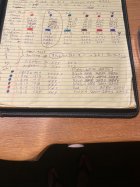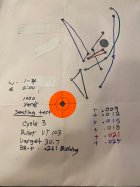I've read that reloaders will use a OAL gauge, modified case, bullet comparator, and projectile (or other means) to measure distance to the lands to determine their seating depths for accuracy tests. The recommended OAL/COL starting point is .002" less than where the bullet touches the lands (or the portion of the chamber/bore the projectile is obstructed). When reloaders use this COL to begin accuracy tests, will they usually keep the same .002" COL and adjust powder charges to test for accuracy? Or will they keep the same powder charge and reduce the COL incrementally to look for differences in accuracy?
I have read that pressure increases as seating depth is extended closer to the lands. I assume this is because less gas can escape out the barrel before the bullet obturates and seals the chamber. But it is also said that pressure decreases as your seating depth is set longer. Is the "pressure decrease from longer seating depth" theory usually just a measure of pressure difference inside the case? If it is a measure of overall pressure difference in the chamber, then that contradicts the theory that pressure increases as bullets are seated closer to the lands. Perhaps most reloaders are seating their bullets far enough from the lands that there is usually an overall decrease in pressure with longer OAL's, and as your OAL is set closer and closer to the lands, the pressure difference may shift from a decrease to an increase.
Also, isn't it true that when using a fast burning pistol powder in a rifle cartridge with reduced powder charges (for example Hodgdon publishes 3.6gr of Titegroup for subsonic .223 loads), pressures increase and may spike dangerously if COL's are set longer due to the possible reaction of pistol powder detonation inside a case with that much empty case space? This contradicts "pressure decrease from longer seating depths" too, but I imagine there's a whole different set of rules and reactions when dealing with fast powders and empty case space.
I have read that pressure increases as seating depth is extended closer to the lands. I assume this is because less gas can escape out the barrel before the bullet obturates and seals the chamber. But it is also said that pressure decreases as your seating depth is set longer. Is the "pressure decrease from longer seating depth" theory usually just a measure of pressure difference inside the case? If it is a measure of overall pressure difference in the chamber, then that contradicts the theory that pressure increases as bullets are seated closer to the lands. Perhaps most reloaders are seating their bullets far enough from the lands that there is usually an overall decrease in pressure with longer OAL's, and as your OAL is set closer and closer to the lands, the pressure difference may shift from a decrease to an increase.
Also, isn't it true that when using a fast burning pistol powder in a rifle cartridge with reduced powder charges (for example Hodgdon publishes 3.6gr of Titegroup for subsonic .223 loads), pressures increase and may spike dangerously if COL's are set longer due to the possible reaction of pistol powder detonation inside a case with that much empty case space? This contradicts "pressure decrease from longer seating depths" too, but I imagine there's a whole different set of rules and reactions when dealing with fast powders and empty case space.

















